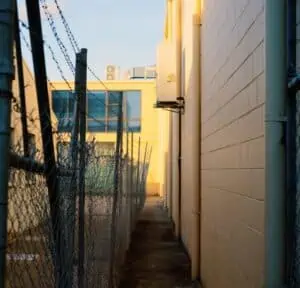What Materials Can Be Used For Fencing Repair?
If your fence is in need of repair, you have options. You can choose to replace the entire fence or fix individual components that have become damaged. Choosing whether to replace or repair can be a big decision that depends on how much time and money you want to invest.
(Looking for “Reliable Fence Services“? Contact us today!)

Wood Fencing:
Most residential fencing is made of wood, whether it’s a simple wooden privacy fence or a taller spaced picket fence. It’s common to use treated wood for fences because it’s resistant to rot and other damage. It can be painted or stained to match your yard and is easy to refinish.
Depending on your location, you may have to replace certain components of your fence to meet local codes or restrictions. You can check with your landowner’s association or city for any rules on height, material, and design for fencing.
Chain Link:
If your chain link fence has a gate that isn’t properly aligned, you can usually fix it by adjusting the hinge pins. To do this, loosen the pins and reposition them. If the gate is too far off, you’ll need to hire a professional for this job.
Vinyl:
If the damage to your vinyl fence is small, you can often repair it with a simple vinyl fence repair kit. These kits typically include a rust-resistant screwdriver, a small hammer, and some screws.
Wrought Iron:
When decorative sections of wrought iron fence separate, you can sometimes rejoin them with an epoxy repair putty. This is a more economical option than welding them together, which would typically require a professional.
Concrete, Stucco, Brick, and Block:
These materials can make your home look regal but also come at a steep price. They’re heavy and need a footing poured below the frost line (the depth to which groundwater freezes in winter).
They can be expensive, and they require a professional to install.
Metal:
If you have metal fencing, if the posts are leaning or sagging, they need to be reset. You can break up the concrete footing and insert a new post, or you can install a steel reinforcement.
For the latter, dig a hole that is below the frost line and add 4 inches of crushed stone to the bottom before you insert the new post. Then, tamp down the top of the stone with a tamper or a piece of wood to help it stay in place.
Step 3: Ensure that the end posts are level above the ground and that they are plumb to each other. Then, mark and dig holes for the intermediate posts that will support the fence.
Measure and cut the 2×4 bottom rails to fit snugly between each pair of posts, anywhere from slightly above grade level to 12 inches up. Secure each bottom rail to each post with a 10d galvanized nail driven through the fence post and into the end of the rail on each side, using a level to keep them even.

